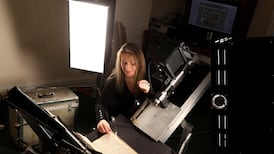Today I bring you the rather sad story of Lise Meitner (1878–1968), co-discoverer, with Otto Hahn (1879-1968) and Fritz Strassmann, of nuclear fission. Hahn won the Nobel Prize for Chemistry in 1944 for this discovery, but Meitner was omitted from recognition. Critics of this decision claim it was the worst example ever of blatant sexism and racism by the Nobel committee.
Lise, third of eight children, was born in 1878 in Vienna to Jewish Austrian lawyer and chess master Philipp Meitner and his wife Hedwig. In 1901, Lise was admitted to the University of Vienna and was awarded a PhD in 1906, the second woman to earn a PhD in physics at the University of Vienna.
Meitner moved on to the Friedrich Wilhelm University where she began a collaboration with chemist Otto Hahn. In 1912, Meitner and Hahn moved to the new Kaiser Wilhelm Institute (KWI) in Berlin. Meitner steadily advanced her research career and in 1917 announced her discovery of the new element Protactinium. In 1926, she was appointed the first woman university physics professor in Germany.
Hitler became chancellor of Germany in 1936 and passed a law banning Jews from the civil service. Although initially exempt from the ban, partly because of her military service during the first World War, Meitner was increasingly harassed by the Nazis and she fled to Stockholm in 1938 where she continued her research, corresponding and collaborating fruitfully with Hahn and his junior chemist colleague Fritz Strassmann in the KWI.
READ MORE
Meitner’s most famous work was jointly discovering nuclear fission with Hahn and Strassman. Scientists were probing the structure/behaviour of the atomic nucleus by observing what happened when uranium, the heaviest natural element, was bombarded with neutrons. Some uranium atoms were transformed into other elements. Scientists believed that the large uranium nucleus absorbs bombarding neutrons and transforms into incrementally larger elements in the periodic table of elements – the transuranium elements. They did not believe the uranium nucleus could fragment.
Meitner was sceptical of this interpretation, postulating instead that nuclear splitting occurs. She christened nuclear splitting “nuclear fission”, analogous to the fission that occurs when a biological cell nucleus divides in two. Meitner proposed a “liquid droplet model” of atomic nuclear structure, likening the forces holding the nucleus together to the surface tension holding the shape of a water droplet.
She proposed that atomic nucleus surface tension weakens as its charge increases, dropping towards zero as the atomic charge gets very high – the large uranium nucleus has a positive charge of 92. This very low surface tension allows the nucleus to split into two fragments when struck by a neutron. The resultant fragments carry away very high kinetic energy – the basis for nuclear power and nuclear weapons – as outlined in The Conversation.
One element produced by nuclear bombardment of uranium behaved chemically like radium. But radium is too big to be a fission product and Meitner thought the element produced was probably barium, chemically very similar to radium and a credible fission product. She told Hahn to search for barium after bombarding uranium with neutrons. Hahn did this experiment and, voila, found the barium – convincing evidence of fission.
Hahn published his results jointly with Fritz Strassman, omitting Meitner’s name. Initially, he claimed Nazi racial politics precluded his public association with a Jewess. He later went way over the top claiming Meitner played “no role” in his discovery, conveniently forgetting that he wouldn’t even have thought to search for barium had Meitner not told him to do so. Strassman disagreed with Hahn, but stood in his shadow. Hahn alone was awarded the Nobel Prize in Chemistry for this work in 1944.
Hahn had difficulty explaining his findings and proposed no credible mechanism as to how uranium splits to produce barium. Soon after Hahn published, Meitner, with her nephew Otto Frisch, published a famous letter in Nature on February 11th, 1939, explaining the mechanism of Hahn’s “discovery” and coining the term “nuclear fission”, which never appeared in Hahn’s paper.
Meitner was invited to participate in the Manhattan Project, but always refused to work on nuclear weapons. The Nobel slight to Meitner was partly healed in 1966 when she, Hahn and Strassmann were jointly awarded the prestigious Enrico Fermi Award for their work, including “experimental studies leading to the discovery of fission”.
Meitner resumed her friendship with Hahn shortly before they died in 1968.
- William Reville is an emeritus professor of biochemistry at UCC













